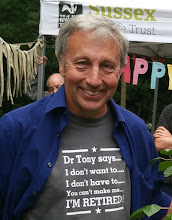We knew it would happen. If government tries to force large numbers of houses into an already crowded part of the country then conflicts were bound to happen. The South East Plan puts local councils in the invidious position of being forced to build over their own countryside.
This is what has happened in Horsham District and this is why we are now faced with mad schemes like the Adversane New Town.
A quiet, rural part of West Sussex, a small hamlet with just a few houses, will turn into an extended sub-urban settlement – 4,000 houses, as many as in Billingshurst and Pulborough combined. We will end up with ribbon development – continuous housing from north of Billingshurst to south of Pulborough – effectively doubling the population of the area to around 26,000 people.
But even bearing in mind the developer’s charter that is the South East Plan, is this inevitable?
The SE Plan dictates that the District must find locations for 13,000 houses yet all the proposals in Horsham’s Core Strategy add up to over 20,000.
Furthermore the SE Plan says that only 3,800 should be outside the Gatwick area (so why are there proposals for at least 4,000 in Adversane alone?).
Carry on reading the SE Plan and you find clear policies stating that at least 60% of any new development should be on previously developed land, otherwise known as brown field land. What is more, there are key policies about protecting the landscape, conserving and enhancing wildlife and building in such a way as to retain and enhance the character of an area. None of the plans in Horsham’s Core Strategy are for houses on brown field land and all the proposals will harm the character of the area.
Do the sums. Even if we accept the SE Plans demands (which I do not) we should be looking for locations for 3,800 homes in rural Horsham, of which 60% (2,280) should be on brown field land. This leaves only 1,520 to be placed on green field sites in rural Horsham. A large number certainly, but nothing like the 20,000 in the current Core Strategy.
Maybe it is disingenuous of the SE Plan. There may not be enough previously developed land in rural areas, like Horsham, to be able to keep all this housing away from green field land. Maybe Horsham District Council are not trying hard enough to find brown field sites, or maybe they are just not there to be found.
But government would never dream of reducing the housing allocation because it can’t be met on brown field sites.
Why is it that every time there is a conflict of policies it is always the environment that looses out?
The pattern is always the same:
You can’t put all the houses on brown field land so don’t reduce the number, just put them on green field land – forget environmental protection.
If there isn’t enough water then just find some more, no matter what the environmental damage.
The roads get congested, so just build them bigger and don’t listen to the complaints of the people who have had their lives ruined.
We are often told, in situations like this that “difficult choices may have to be made”. In practice, whenever people in authority say this, it means they want to be able to make the easy choice, not the difficult one.
In this case the easy choice will be to ignore everyone and over-develop the area come-what-may.
The difficult choice would be to plan within the ability of the area to absorb development. And if this means less development – then that is the difficult choice.

No comments:
Post a Comment